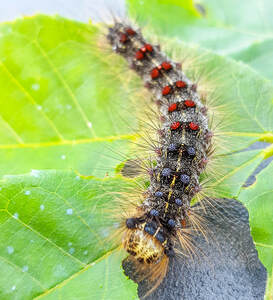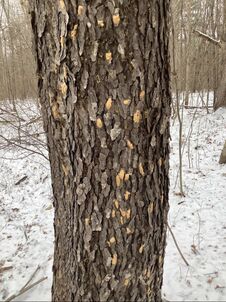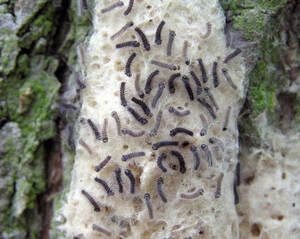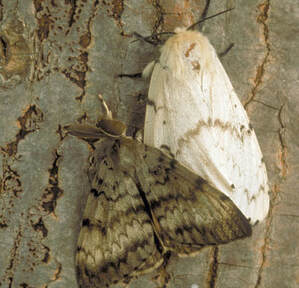Spongy moths (Lymantria dispar)* are believed to have escaped cultivation near Boston, MA in 1869. Since their introduction, spongy moth populations have expanded throughout the Northeast and into the Mid-Atlantic and Great Lakes Regions. Spongy moth caterpillars are voracious eaters. A single caterpillar can consume up to one ft² of leaves a day. In 2020, nearly 1 million acres were defoliated by spongy moth caterpillars.
Caterpillars will feed on more than 300 species of trees and shrubs. Oaks are the preferred hosts, but they will also feeds on aspen, apple, basswood, birch and willow. If defoliation is especially intense, mature caterpillars may even attack evergreens like pine and spruce. Repeated defoliation can leads to severe tree stress and even death. Infested trees can survive spongy moth infestations given proper care and maintenance. Most broadleaf trees can tolerate complete defoliation for a few years, but defoliated conifer trees are unlikely to survive.
If you have spongy moth caterpillars or egg masses on your property, you can report it on the Midwest Invasive Species Information Network, or email us [email protected]. A representative of the SB-CISMA will contact you shortly about your submission.
Caterpillars will feed on more than 300 species of trees and shrubs. Oaks are the preferred hosts, but they will also feeds on aspen, apple, basswood, birch and willow. If defoliation is especially intense, mature caterpillars may even attack evergreens like pine and spruce. Repeated defoliation can leads to severe tree stress and even death. Infested trees can survive spongy moth infestations given proper care and maintenance. Most broadleaf trees can tolerate complete defoliation for a few years, but defoliated conifer trees are unlikely to survive.
If you have spongy moth caterpillars or egg masses on your property, you can report it on the Midwest Invasive Species Information Network, or email us [email protected]. A representative of the SB-CISMA will contact you shortly about your submission.
Identification
- Egg masses a pale, putty-like substance. Present from September to April.
- Eggs hatch in April or early May.
- Early instars are smaller than a dime, head a black head capsule with irregular yellow markings.
- Large instars have a yellow and black head with 5 pairs of blue spots, and 6 pairs of red spots.
- Caterpillars feed at night, hide in bark and leaf litter during the day.
- Pupate into adults in June-July.
- Male adults are dark brown with dark wing markings.
- Female adults are white with brown marking; cannot fly.
Additional Resources
Homeowner's Guide to Managing Spongy Moth
Bay County Spongy Moth Suppression Program
MSU Spongy Moth IPM
Natural Enemies of Spongy Moth
Michigan Invasive Species Website
Spongy Moth FAQ
Homeowner's Guide to Managing Spongy Moth
Bay County Spongy Moth Suppression Program
MSU Spongy Moth IPM
Natural Enemies of Spongy Moth
Michigan Invasive Species Website
Spongy Moth FAQ
Banner Credit: Karla Salp, Washington State Department of Agriculture, Bugwood.org
*On March 2, 2022 the common name of Lymantria dispar, was officially changed from "gypsy moth" to "spongy moth" by the Entomological Society of America out of respect for Romani people. To learn more about this change, visit https://entsoc.org/publications/common-names/spongy-moth.




